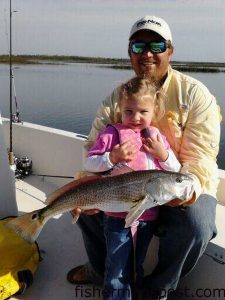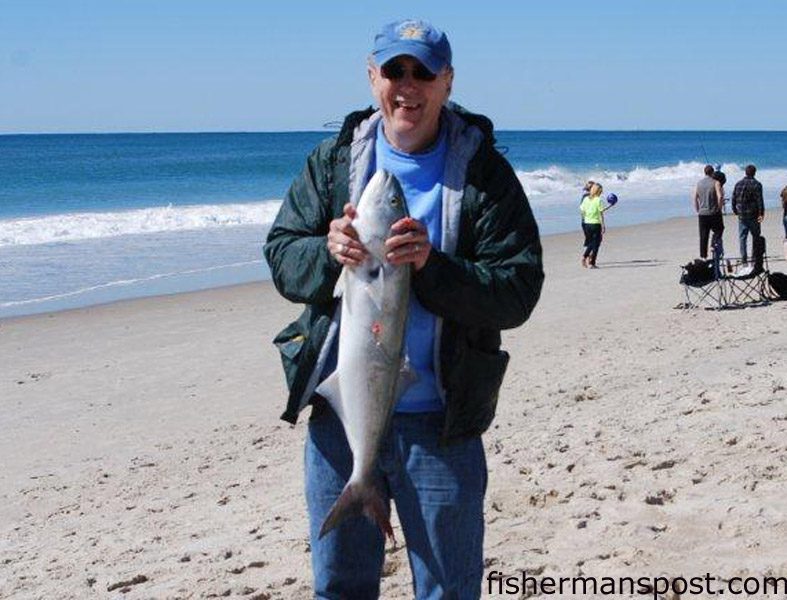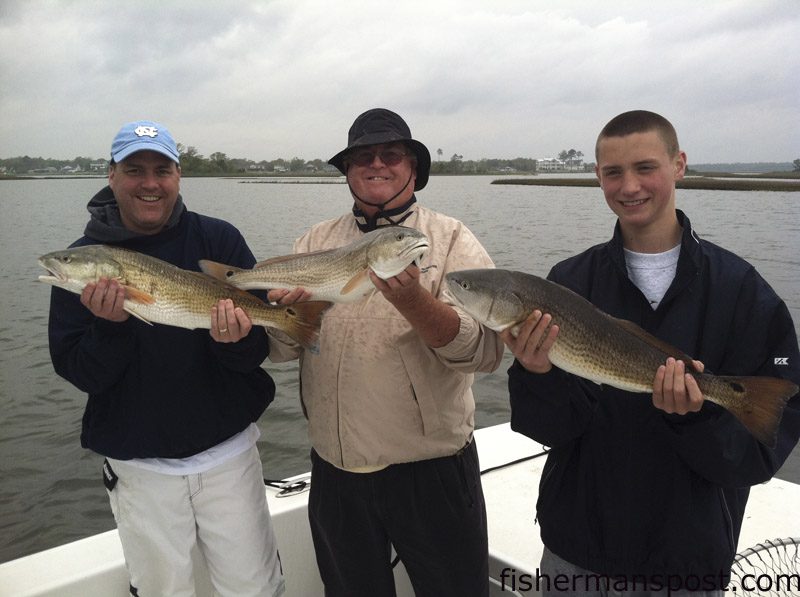Swansboro April 12, 2012

Lauren Hall with an upper-slot red drum she landed after it fell for a Gulp bait in a bay near Bogue Inlet while she was fishing with her parents, Kristin and Capt. Robbie Hall, of Hall'Em In Charters out of Swansboro.
Rob, of Sandbar Safari Charters, reports that the spring fishing continues to improve thanks to the warm water in the area.
Red drum have been providing consistent action in the bays and marshes inshore of the barrier islands. At higher tides, casting mud minnows and Gulp baits beneath popping corks along the flooded grass edges has been a very effective tactic lately. When the water’s lower, anglers can sight-cast Gulp baits to the fish in the more open water. Topwater plugs have also been working on the calm, warmer days lately.
Flounder are starting to feed inshore, with smaller fish on the flats and larger ones moving into the inlets and nearby channels and deeper holes. Live mud minnows and Gulp baits on heavier jigheads or bucktails are both tough for the flounder to turn down.
The flounder bite is also turning on at oceanic structure within 5-6 miles of Bogue Inlet, where larger bucktail/Gulp combinations are the most effective weapons.
Speckled trout are moving out of the smaller creeks in the area and are feeding around creekmouths, oyster rocks, and cuts in Queen’s Creek and the White Oak River (mostly smaller fish). Gulp and other shrimp imitations fished under popping corks are excellent choices for the specks.

Bill Freeman, of Winston-Salem, NC, with a 31" bluefish that bit fresh shrimp in the Emerald Isle surf.
Sea mullet and gray trout are feeding along the beachfront and moving into deeper water inshore. Fish Bites Clam Strips are tough to beat for the mullet, and Gulp baits or smaller jigging lures will tempt bites from the grays.
Some spanish mackerel have been caught from the pier already along with plenty of bluefish.
The blues have also moved inshore and are feeding around the inlets and nearby deeper channels, where they’ll bite soft plastics or virtually any other lures that anglers can cast.
Robbie, of Hall’Em In Charters, reports that schooling red drum are providing plenty of excitement for Swansboro-area anglers right now (with most fish 22-30”). Schools of 20-100 drum are feeding in the bays behind the barrier islands, and anglers can either find them and sight-cast, or they can blind fish and hook up. The fish are starting to respond well to topwater plugs, especially when it’s calmer. When they don’t want to eat on top, Gulp baits and cut mullet are tough for the reds to turn down.
Flounder are also making a good (and early) showing inshore, and decent numbers of keeper fish are starting to be in the mix. Creekmouths behind the barrier islands have been producing the most consistent action with the flatfish lately, and Gulp Jerk Shads and other baits on 1/4 oz. jigheads are tempting them to bite.
Sea mullet and gray trout have moved into deeper channels around the inlet, ICW, and Swansboro waterfront. Shrimp and clam-flavored Fish Bites on bottom rigs and spec rigs will draw plenty of bites from both of the tasty bottom feeders.

Bennett Roberts, Mel Fairchild, and Nick Roberts with a trio of slot red drum they hooked on Gulp baits on light jigheads in a shallow marsh behind Bear Island. They were fishing with Capt. Rob Koraly of Sandbar Safari Charters.
Rich, of The Reel Outdoors, reports that offshore trollers are finding solid action with dolphin and wahoo when the weather lets them make it out to the break. Trolling ballyhoo and skirted lures is the way to tempt bites from both.
The first few cobia have been caught at Cape Lookout Shoals, so anglers hope it won’t be long until they make an appearance off Bogue Inlet. Bait and large rays are already in the area, and the cobia usually accompany both.
Plenty of bluefish and a few spanish mackerel have been coming over the rails of the pier for anglers working Gotcha plugs.
Bottom fishermen on the pier and beaches are connecting with some sea mullet, pufferfish, and even a few early pompano while baiting up with shrimp.
Joanne, of Bogue Inlet Pier, reports that plug casters landed the first spanish mackerel of the year over the past week. Plenty of bluefish have also been falling for lures that anglers are working from the pier.
Bottom fishermen baiting up with shrimp have been catching good numbers of sea mullet and pufferfish, a few black drum, and even some pompano.
